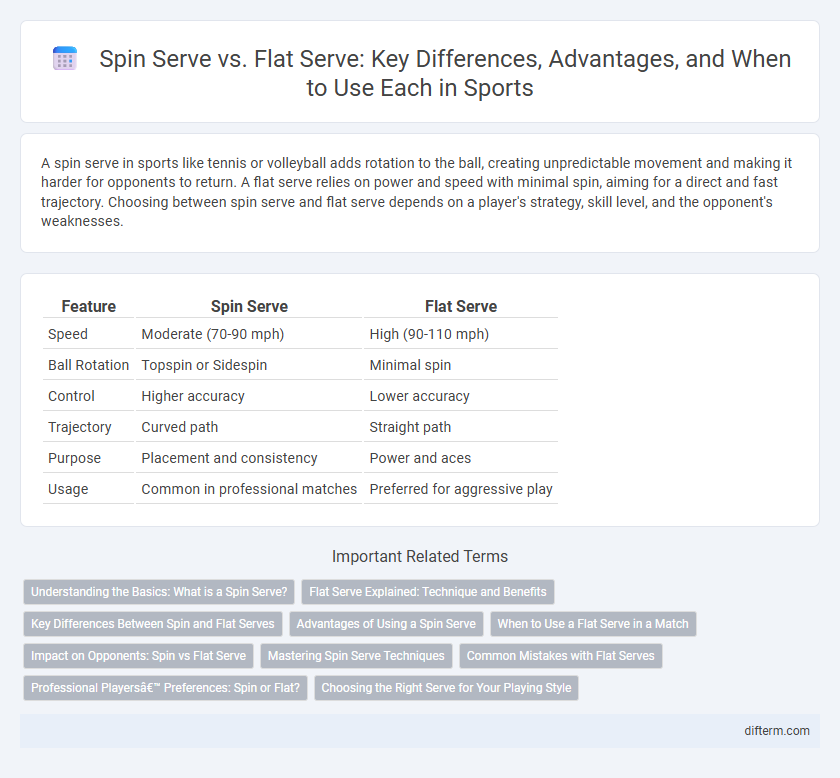A spin serve in sports like tennis or volleyball adds rotation to the ball, creating unpredictable movement and making it harder for opponents to return. A flat serve relies on power and speed with minimal spin, aiming for a direct and fast trajectory. Choosing between spin serve and flat serve depends on a player's strategy, skill level, and the opponent's weaknesses.
Table of Comparison
| Feature | Spin Serve | Flat Serve |
|---|---|---|
| Speed | Moderate (70-90 mph) | High (90-110 mph) |
| Ball Rotation | Topspin or Sidespin | Minimal spin |
| Control | Higher accuracy | Lower accuracy |
| Trajectory | Curved path | Straight path |
| Purpose | Placement and consistency | Power and aces |
| Usage | Common in professional matches | Preferred for aggressive play |
Understanding the Basics: What is a Spin Serve?
A spin serve in sports like tennis and table tennis involves applying rotational force to the ball, causing it to spin rapidly during flight. This spin affects the ball's trajectory, bounce, and speed, often making it harder for opponents to predict and return effectively. Players use various grips and wrist movements to generate topspin, backspin, or sidespin, enhancing control and strategic play.
Flat Serve Explained: Technique and Benefits
The flat serve in tennis is executed by striking the ball at a higher point with minimal spin, generating maximum speed and a direct trajectory. This technique involves a precise toss, strong wrist snap, and full extension of the arm to maximize power and accuracy. Players benefit from flat serves as they are effective for aces and forcing weak returns, making them a crucial weapon in aggressive service games.
Key Differences Between Spin and Flat Serves
Spin serves generate rotational force on the ball, causing it to curve and bounce unpredictably, which disrupts the opponent's timing and positioning. Flat serves emphasize speed and power with minimal ball rotation, aiming for maximum velocity and a direct trajectory to overpower the receiver. The key differences lie in spin rate, ball trajectory, and strategic purpose, with spin serves enhancing control and deception, while flat serves prioritize raw speed and aggressive placement.
Advantages of Using a Spin Serve
A spin serve in tennis generates increased ball control and greater margin for error by imparting topspin or slice, causing the ball to drop sharply and bounce unpredictably. This advantage forces opponents into defensive positions, limiting their aggressive shot options and increasing the likelihood of unforced errors. Players using spin serves can vary speed and trajectory, making it difficult for returners to anticipate and adjust, enhancing overall serve effectiveness.
When to Use a Flat Serve in a Match
Use a flat serve in a tennis match when aiming for maximum speed and power to dominate the opponent early in the point. This serve is most effective on faster surfaces like grass or hard courts where it can generate an ace or force a weak return. Players often deploy the flat serve during crucial points such as break points or to finish a game quickly due to its low margin for error but high potential reward.
Impact on Opponents: Spin vs Flat Serve
Spin serves create unpredictable ball trajectories and variable bounce angles, complicating opponents' timing and positioning, which often forces defensive returns. Flat serves deliver high speed and power with a more direct trajectory, putting immediate pressure on opponents by reducing their reaction time and increasing the likelihood of errors. Understanding these differences helps players strategically choose serves to exploit opponents' weaknesses and control the pace of the game.
Mastering Spin Serve Techniques
Mastering spin serve techniques in tennis enhances control, speed, and unpredictability, giving players a competitive edge over flat serves. By applying topspin or slice, players create a ball trajectory that dips faster and bounces higher, forcing opponents into defensive positions. Consistent practice of grip adjustments, wrist snap, and toss precision is crucial to effectively executing spin serves and dominating service games.
Common Mistakes with Flat Serves
Common mistakes with flat serves include improper wrist snap and overextension, leading to reduced control and accuracy. Many players fail to generate sufficient racket head speed, resulting in less power and predictability. Neglecting consistent toss placement often disrupts timing, causing frequent faults and lost points.
Professional Players’ Preferences: Spin or Flat?
Professional players often prefer spin serves for their increased control and ability to create unpredictable ball trajectories, essential in high-level tennis matches. Flat serves are favored for their speed and power, often used as an aggressive tactic to force aces or weak returns. The choice between spin and flat serves depends on the player's style, with top athletes like Rafael Nadal excelling in spin serves while others like Roger Federer utilize flat serves to dominate points quickly.
Choosing the Right Serve for Your Playing Style
Choosing the right serve between a spin serve and a flat serve depends on your playing style and strategic goals. Spin serves create unpredictable ball movement, making them ideal for players who rely on precision and forcing errors. Flat serves deliver maximum speed and power, suited for aggressive players aiming to dominate points quickly.
Spin Serve vs Flat Serve Infographic

 difterm.com
difterm.com